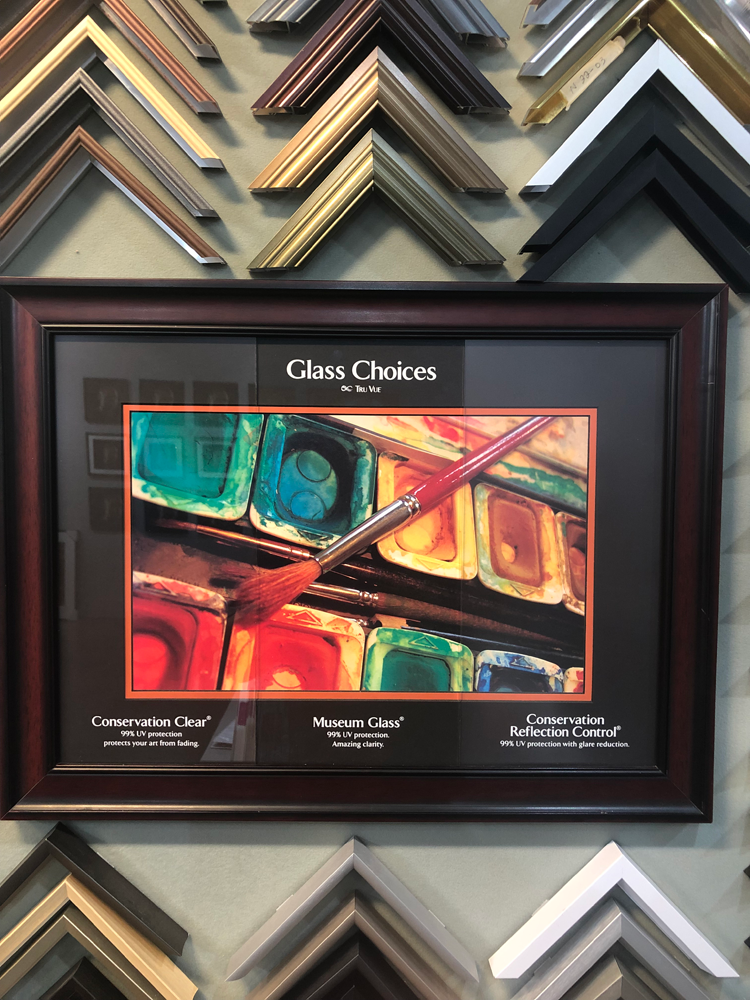 Glass
Glass
The art of custom framing has been around for centuries, and throughout the years, innovation in great lengths has taken place throughout the industry. From acid free mats and mounting boards, to the double miter saw and automatic v-nailer for cutting and joining frames with great precision and efficiency, the industry is constantly evolving.
With no discredit to the leaps and bounds this industry has seen throughout the years, one recent innovation that stands out in my opinion is the creation and introduction of museum glass.
Ooohhh… Museum glass sounds fancy… and expensive. Well – it is. No words can or are needed to sell it. After all the framing decisions have been made, my final question to the client is: What type of glass would you like? More often than not, their answer is “Glass type? What do you mean? We have an option?” That’s when I show them a framed sample hanging on the wall, with three panes of glass practically seamless, covering the front of the artwork: regular on the left, non-glare on the right and museum glass in the centre. 30 seconds later, the question is asked: “What am I looking for?” Then I tap on the centre pane of glass. The look on the client’s face is priceless. “I thought there was no glass there!” they say. Although I have never been a fan of upselling, I have had clients disappointed when I did not give them the option. So now I offer specialty glass to all clients framing original art, fabric, photographs or anything else of value, monetary or sentimental.
Museum glass not only looks practically invisible, it also filters out 99% of UV light and is as such conservation grade, hence the name Museum. This brings us to its rebel cousin, Art Glass, my personal favourite. Optically, it is identical to museum glass, with 2 differences. It filters 70% of UV light and is approximately 40% less expensive. Why is it my favourite you ask? As compared to regular glass, Art glass gives you a much more beautiful finished product with its anti-reflective finish. While UV filtering glass only slows the process of deterioration in the art work down, it does not eliminate it, even when you have 99% filtering. The best way to protect your artwork from damage from ultraviolet rays is not to expose it, and that isn’t very enjoyable, is it? So hang it, look at it, love it, and let others enjoy it.
Museum and Art glass comes in sizes as large as 48” x 68”. Museum glass is also available as 48” x 96” in acrylic. Museum glass retails for $65 for a 16” x 20” piece (¼ sheet), and Art is $45 for the same size. However, keep in mind that these are not the only options for protecting your artwork!
Other glass options are available, such as
| Regular Glass | 45% UV filter |
| Non-glare Glass (fuzzy) | 45% UV filter |
| Art Glass | 70% UV filter |
| Conservation Clear Glass | 99% UV filter |
| Conservation Reflection Control Glass (non-glare, fuzzy) | 99% UV filter |
| Museum Glass | 99% UV filter |
| Acrylic | 66% UV filter |
| Optium Museum Acrylic | 99% UV filter |
Next time you visit your framer (preferably us!), ask to see the Museum or Art glass. Remember both are almost invisible and are not non-glare (the fuzzy one). For more extensive product information, visit the manufacturer’s web site directly at tru-vue.com.
Steve Morkotinis





